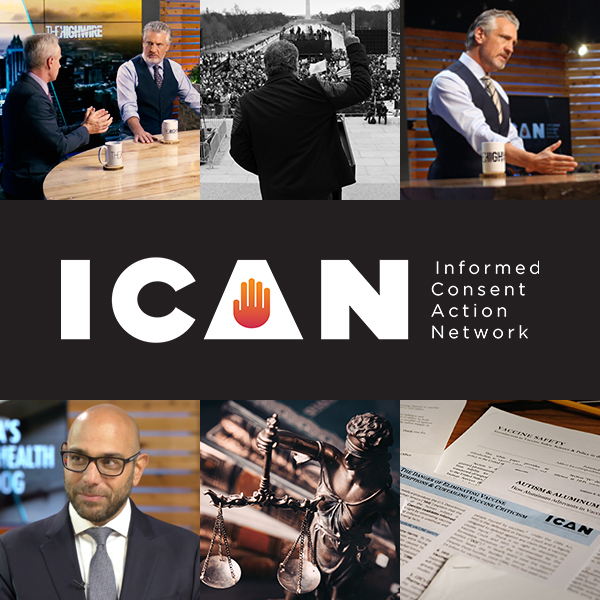

A significant amount of the breaking news that ICAN has had about our federal health agencies is thanks to information it has uncovered under one single piece of legislation: The Freedom of Information Act (FOIA). ICAN’s attorneys have used this Act to uncover an amazing amount of information that our government would prefer not to be public—including our recent update revealing that CDC knew about breakthrough infections as early as March 2021! But it’s no simple process. Here’s an inside look at how the FOIA process works.
The Freedom of Information Act is a law that allows the public to monitor how (and if) the federal government is fulfilling its responsibilities. Since federal employees work for the American people—we pay their salaries with our taxes—we have the right to see what they are doing. While there are some restrictions on what the public can view (such as national security or trade secrets), anyone can request access to agency records, including emails, meeting memos, reports, etc.
ICAN’s attorneys, led by Aaron Siri, have submitted close to 1,800 FOIA requests to date. Making the request is just the first step though. Siri outlined this complex process on a recent episode of The HighWire. Here are just some of the details on the FOIA request that led to our recent update about breakthrough infections, a related request regarding reinfection, and additional requests which resulted from these. The saga began over two years ago in 2021:
- July 16, 2021: ICAN, through its attorneys, files a FOIA request for any documents received by CDC from the California Department of Public Health (CDPH) relating to COVID-19 vaccine breakthrough infections.
- July 19, 2021: ICAN files a second FOIA request for any documents received by CDC from CDPH relating to cases of COVID-19 re-infections.
- September 8, 2021: CDC denies both requests, stating that it cannot release the records due to a Data Use Agreement it has with the State of California.
- October 15, 2021: ICAN submits a third FOIA request, this time asking for a copy of that Data Use Agreement.
- October 19, 2021: ICAN files an appeal for both original FOIA requests, claiming that CDC’s reliance on the Data Use Agreement to deny the requests was improper.
- December 9, 2021: In an unusual move, CDC doesn’t wait for the appeal to be decided and instead asks that the requests be remanded to CDC for further processing.
- June 24, 2022: Finally, after 49 weeks, three requests, and an appeal, ICAN receives documents from CDC regarding the first FOIA request on breakthrough infections. And it was worth the wait! Read more about what the documents revealed in our previous update. The response also mentioned that there were five pages held back that were being evaluated by the Department of Defense (DOD).
- July 20, 2022: CDC responds to the second FOIA request on cases of COVID-19 reinfections claiming it can’t find a single record.
- July 20, 2022: On the same day, CDC also responds to the third FOIA request for the Data Use Agreement claiming it can’t find that either!
- August 17, 2022: ICAN files an appeal for the third FOIA request arguing that CDC failed to conduct an adequate search for the Data Use Agreement given that CDC relied on it to deny the initial request – it must exist, no? Seems not.
- September 26, 2022: ICAN files an appeal for the first FOIA request arguing that the CDC failed to conduct a thorough search for documents pertaining to breakthrough infections. While CDC had produced documents related to this request on June 24, there was evidence that other relevant documents had been left out.
- October 17, 2022: ICAN files an appeal for the second FOIA request arguing that CDC failed to conduct an adequate search for records on re-infection.
- January 3, 2023: The DOD produces the five pages from the first FOIA request which included July 2021 emails from a DOD contractor noting there were 80,000 breakthrough cases among 7 million fully vaccinated Medicare beneficiaries with a 10% hospitalization rate and 3% death rate.
There is more but the above is sufficient to give you a taste of just part of the life cycle of two related FOIA requests, neither of which are complete and may require additional action, including potentially a lawsuit if CDC does not satisfy the pending appeals. As you can see, FOIA is a process that takes patience and persistence. It is not as simple as filing one request and receiving documents. ICAN is thankful for supporters like you who help fund this vital work.
See below for more instances where ICAN used FOIA to uncover “health” agencies making unsupported claims to the public:
- ICAN DEMANDS ANSWERS ABOUT DEATH DISCREPANCIES IN PFIZER’S CLINICAL TRIAL
- CDC ADMITS ONCE AND FOR ALL IT HAS NO BASIS FOR ITS CLAIM THAT COVID-19 VACCINES DO NOT CAUSE VARIANTS
- THE CDC’S RESPONSE TO SCIENTIFIC INQUIRY: BECAUSE WE SAID SO!
- CDC HAS NO RECORDS TO SUPPORT CLAIM THAT COVID VACCINES DO NOT CAUSE VARIANTS
